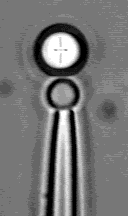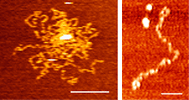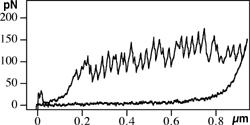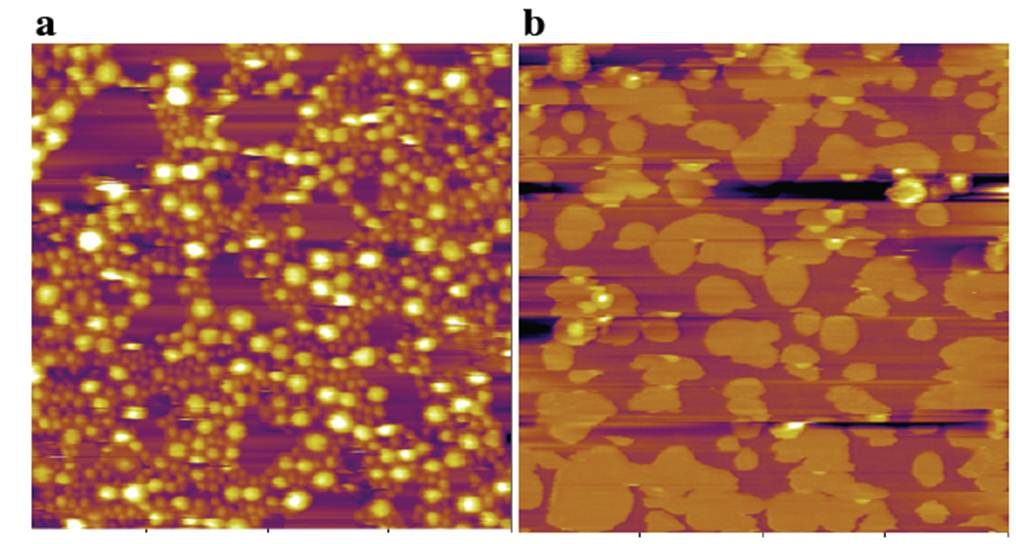Projects
Molecular mechanics of the giant muscle protein titin
The giant muscle protein titin spans from the Z- to the M-line of the muscle sarcomere. It plays an important role in determining the elasticity mechanical stability of the sarcomere. The molecular basis of the elasticity and mechanical stability of titins various sub-molecular segments and domains is not fully understood. It is also unclear how sarcomeric components might modulate titins behavior. We express various titin segments and study their mechanical properties and force-driven structural transitions using optical tweezers and single-molecule AFM. In addition, fluorescently labeled titin and titin domains are studied with various spectroscopic techniques and TIRFM.
 Titin molecule stretched with optical tweezers. Upper bead captured in optical trap, lower one held with moveable glass micropipette. As the pipette is moved downwards, the trapped bead moves slightly with it, indicating that there is an elastic coupling - via titin - between the two beads.
Titin molecule stretched with optical tweezers. Upper bead captured in optical trap, lower one held with moveable glass micropipette. As the pipette is moved downwards, the trapped bead moves slightly with it, indicating that there is an elastic coupling - via titin - between the two beads.
 Non-contact mode AFM images of titin. Single molecule on left, oligomer on right. Scale bar 0.3 µm.
Non-contact mode AFM images of titin. Single molecule on left, oligomer on right. Scale bar 0.3 µm.
 Force versus extension curve of titin obtained with AFM. The repetitive sawtooth-like transitions seen during stretch correspond to single-domain unfolding events.
Force versus extension curve of titin obtained with AFM. The repetitive sawtooth-like transitions seen during stretch correspond to single-domain unfolding events.
 Laser scanning confocal microscopic image of surface-adsorbed, TMRIA- labeled titin. Fluorescence on left, surface plot on right.
Laser scanning confocal microscopic image of surface-adsorbed, TMRIA- labeled titin. Fluorescence on left, surface plot on right.
 TMRIA-labeled titin stretched with meniscus forces.
TMRIA-labeled titin stretched with meniscus forces.
In vitro motility of human cardiac contractile proteins
Myosin and native thin filaments are isolated from minuscule human cardiac muscle samples obtained during cardiac surgery . The proteins are studied in the in vitro motility assay.
Mechanics of cytoskeletal proteins
Desmin, purified from chicken gizzard, is mechanically manipulated using single-molecule AFM.
Nanomechanics of collagen
Different types of collagen (I and IX) are studied with AFM. Collagen I is also explored in situ, in the dentin of human teeth.
Molecular mechanics of DNA and chromatin
Lambda phage DNA is stretched with optical tweezers. Histone proteins are purified from calf thymus. Histones and DNA are combined to form reconsituted chromatin, which is stretched with optical tweezers.
Protein folding and mechanics of amyloid fibrils
Amyloid fibrils are formed from various synthetic beta amyloid fragments. The fibrils are imaged and mechanically manipulated with AFM.
Interaction of phospholipid vesicles with solid surfaces
Liposome attachement and supported lipid bilayer formation are followed with Confocal Microscopy and AFM.
 Supported vesicular layer (a) and supported bilayer (b) formed by DPPC vesicles on mica surface. Image size: 2x2 µm each.
Supported vesicular layer (a) and supported bilayer (b) formed by DPPC vesicles on mica surface. Image size: 2x2 µm each.



